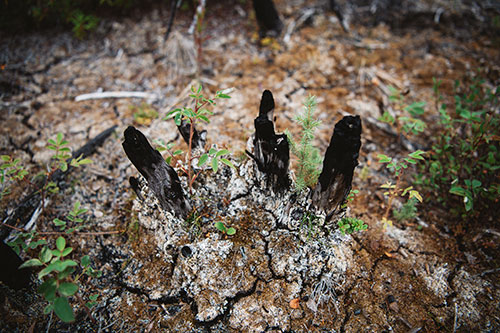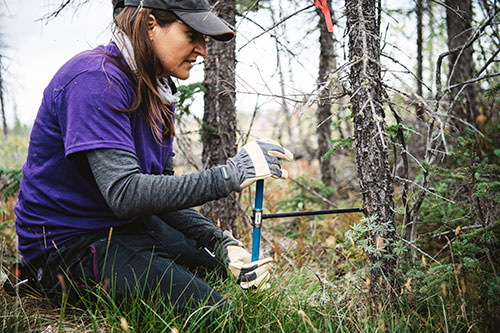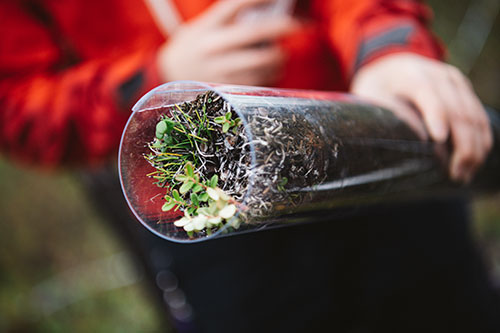Confronting a Fiery Future
As wildfires intensify across the Northwest Territories, Laurier’s Jennifer Baltzer is working with local partners to protect forest ecosystems and surrounding communities.

In the aftermath of a forest fire, scenes of destruction remain. Though ominous, the scorched stumps and charred earth make way for regrowth and new life to emerge from the forest floor. Fire is critical to forest renewal.
But what happens when fire reignites before regeneration can occur? In the boreal forests of Northern Canada, holdover fires continue to smoulder beneath the ground throughout the winter, insulated by peaty soils, and ignite again the following spring. These fires, commonly described as “zombie fires,” are a signal of a warming climate. Holdover fires could be damaging to northern ecosystems and communities, and the global effort to combat climate change.
Jennifer Baltzer is the Canada Research Chair in Forests and Global Change at Wilfrid Laurier University. During the summer of 2022, she and her colleagues were the first-ever research team to collect field data on holdover fires. They helicoptered to more than a dozen remote locations throughout the Northwest Territories to evaluate key differences between holdover and single-season fire sites from 2014, the territory’s worst fire season in history.
“The holdover fire sites were apparent from the air. The trees are completely flattened and there continues to be a productive population of fireweed, a purple flower that grows following a fire,” says Baltzer. “Fireweed gets shaded out as healthy regeneration occurs. At the single-season fire sites, fireweed is gone.”
These and other signs point to what Baltzer calls a “loss of ecological resilience” following holdover fires. Shifts in the dominant tree species were found at nearly every site they visited and can have wide-ranging effects on forest ecosystems, affecting the water cycle, wildlife habitats and carbon storage.
While less dramatic than towering flames, the persistent smouldering of holdover fires releases huge amounts of carbon dioxide into the atmosphere, some of which has been stored in the soil for decades or even centuries.
“30 to 40 per cent of the Earth’s carbon is locked up below ground in boreal and Arctic ecosystems, and carbon uptake by these forests helps to offsets our global emissions,” says Baltzer. “If these soils are unable to store carbon in the same way, that has major implications for the warming of our planet.”
Northern Canada is warming three to four times faster than the global average and Olsen is prepared for “the extremes to become more extreme.” He is turning to Baltzer for answers.
Supporting the Laurier team in their field research was Richard Olsen, manager of Fire Operations for the Government of the Northwest Territories. Holdover fires have been a pressing concern for fire management crews during recent years, a driver of earlier and increasingly unpredictable fire seasons. Northern Canada is warming three to four times faster than the global average and Olsen is prepared for “the extremes to become more extreme.” He is turning to Baltzer for answers.
“Our focus has been on understanding these larger trends,” says Olsen. “The more we know about what the future might hold, the better it’s going to be for us to make decisions about preparedness and response.”
Fire preparedness is critical in a territory where almost everyone lives “mere steps” away from a forest. As wildfires become more frequent and severe and their footprint across the North increases, there are great risks to transportation routes, critical infrastructure such as power and telecommunication lines, and human life. Olsen is working with Baltzer and her collaborators to learn what conditions predict extreme fire behaviour, such as the severe drought that preceded the record-breaking fire season of 2014.
“During that season, there were 2.4 million hectares on fire throughout the territory at one time,” recalls Andrew Applejohn, senior science advisor for the Government of the Northwest Territories. “It was shocking to see the impacts of those fires on landscapes and communities. Natural resources were impacted significantly and air quality issues were foremost on people’s minds. I remember my parents called me one day and said, ‘We saw on the national news that Yellowknife is completely surrounded by forest fires.’”
“It was just an unbearable amount of smoke and had a major impact on our ability to be outdoors,” says Baltzer, who was living in Yellowknife with her family at the time. “The highway was closed pretty regularly because of massive fires on both sides of it, so you would often get stuck on one side or the other. That created additional challenges for folks living in Yellowknife because delivery trucks couldn’t make it into the city.”


Following that summer, Olsen says there was great interest from the scientific community in investigating the causes and impacts of such widespread fires. Baltzer assembled a group of international experts to work with the territorial government to identify the essential research questions they needed to answer. Since then, she and her colleagues have been working to address key community and government concerns about the impacts of these fires.
“I found that Jennifer and Laurier exemplified not just the research and understanding, but the knowledge sharing and community outreach,” says Olsen. “I admire how they are working to incorporate communities into research and their willingness to translate scientific data so that people can digest the information and see the importance for themselves.”
“2014 challenged our understanding of how fires work and there were many questions being asked across northern society,” says Applejohn. “Our government doesn’t have an awful lot of scientists on staff to answer those questions. Jennifer provided leadership and put together an effective team of government and community members. We had an acute need and she was the driving force behind how we delivered answers over the next five years.”
“I found that Jennifer and Laurier exemplified not just the research and understanding, but the knowledge sharing and community outreach.”
Baltzer is one of many Laurier researchers who collaborate with the Government of the Northwest Territories. Since 2010, a government-university partnership has offered research expertise, development and training opportunities to the Northwest Territories, while providing Laurier scholars and students with a range of supports to carry out local research. Laurier maintains more than 50 research sites throughout the territory and a year-round office in downtown Yellowknife.
“Our territory has diverse research needs, from environmental to health and wellness to infrastructure, and through our partnership with Laurier we’ve been able to delve into all of those areas,” says Julian Kanigan, the Northwest Territories’ assistant deputy minister of Environment and Natural Resources. “The fact that Laurier has an office in Yellowknife has enabled us to collaborate much more closely because we have colleagues right here in the territory.”
“There’s a lot of learning that happens both ways,” says Baltzer. “The relationships we have with the government and the infrastructure that has been developed around this partnership is critical to my research program.”
Baltzer works alongside wildlife managers at the Government of the Northwest Territories because changes to forests mean changes to wildlife habitats. She also leads Northern Water Futures, a project focused on northern water resources. And as part of her ambitious research agenda as a Canada Research Chair, Baltzer investigates the effects of permafrost thaw on northern ecosystems.
“Most of the boreal forests in the Northwest Territories are underlain by permafrost, which is perennially frozen ground,” says Baltzer. “As the climate warms, that ground ice is melting and changing the ground surface. That impacts all kinds of things, from water systems to vegetation to roadways. It also impacts where and how trees grow, so we’re trying to link these changes and their implications for northern forests and communities as the system thaws.”
This is not information that can be gathered at a computer. Baltzer’s research takes her deep into nature, to remote parts of the landscape that can sometimes only be accessed by helicopter. It is her favourite part of the job.
During her fieldwork, Baltzer is surrounded by a team of enthusiastic research associates and Laurier students who can be found collecting tree cores to assess how fire has impacted their growth over time, characterizing plant communities to understand impacts to wildlife forage, drilling into the ground to measure ground ice content, and extracting soil samples to evaluate carbon storage.
“It’s a unique ecosystem and a really cool place to come and study,” says Emily Ogden, who recently completed her Master of Science degree under Baltzer’s supervision. “The advantage to doing your master’s at Laurier is that it already has this network of sites and partners throughout the territory that makes projects like mine possible.”


Throughout her research career, Baltzer has studied forests around the world. She worked as a postdoctoral fellow at Harvard University’s Centre for Tropical Forest Science and has done field work in regions as diverse as the Maritimes and southeast Asia. But it’s here in the Northwest Territories that she feels her research can have the most impact.
“People in the North are really living climate change right now. They are faced with daily challenges associated with this rapidly warming climate, more so than many other parts of the planet,” says Baltzer. “What drives my research is being able to work closely with both territorial and Indigenous governments to support planning in the face of these rapid changes. We have been building relationships with Indigenous communities on whose lands we are working to foster knowledge sharing and support adaptation and capacity building.”
According to Applejohn, that impact is already being felt.
“Understanding what’s happening with changing landscapes and fires and thawing permafrost – these are all critical questions about what the future of the North will hold,” he says. “What excites me about our Laurier partnership is that we’re starting to answer some of those questions and we’re beginning to see a path forward.”
“What excites me about our Laurier partnership is that we’re starting to answer some of those questions and we’re beginning to see a path forward.”
Join Laurier and our collaborators as we build a stronger, sustainable future for Northern Canada and our planet.